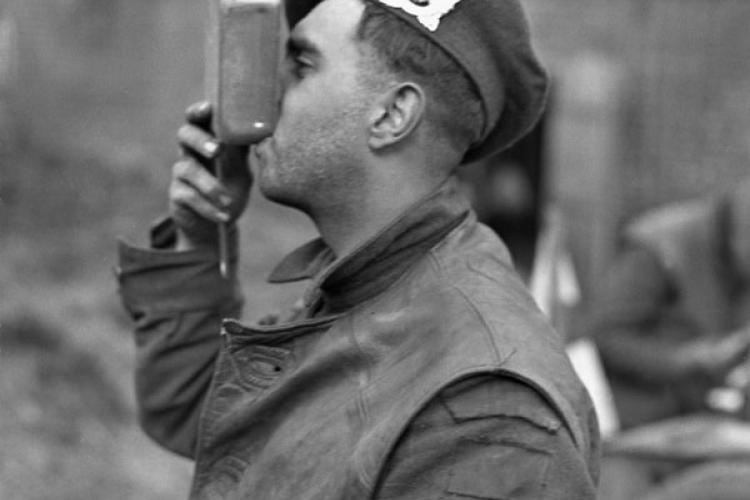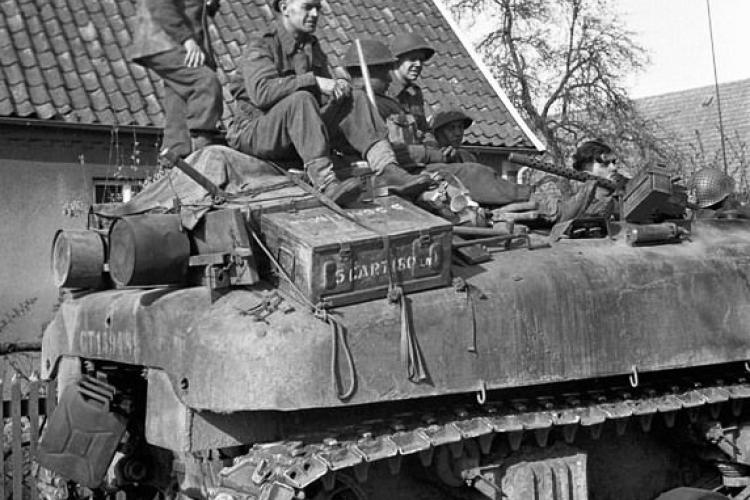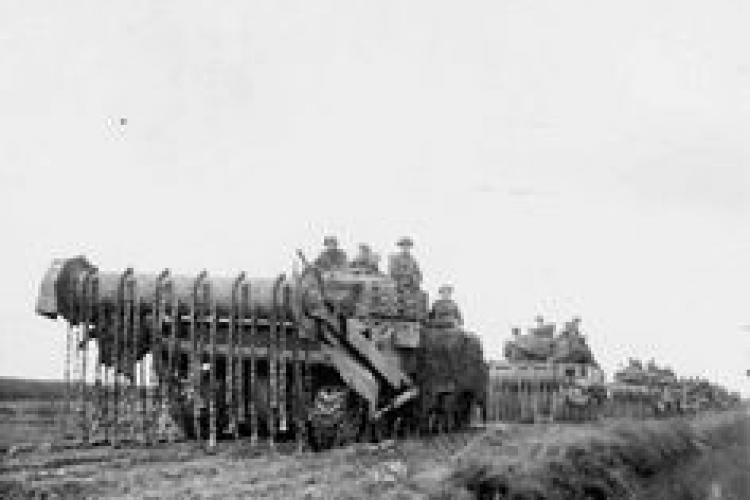Divisional Unit
SERVICE NO: B / 58454
AWARDS: 1939-45 Star / France & Germany Star /
War Medal / Canadian Volunteer Service Medal
DATE OF BIRTH: August 6, 1920 – Newtown Cross – County of Queens –
Prince Edward Island
DATE OF DEATH: April17, 1945 24 years 7 months
WIFE: Mrs. Evelyn Dora Kelly – Halifax – Nova Scotia
BROTHERS: Joseph Edward, Monty Martin, Fallon James, Walter Ambrose,
William Gerald, Pisus Tidelus, Leo Phillip and Michael Earl.
CEMETERY: Edemechterdamm – Germany Cemetery
CEMETERY: Holten Canadian War Cemetery – Overijssel – Netherlands.
VII E 13
Height: 5’ 11” Weight: 167 pounds
Complexion: medium Eyes: blue Hair: brown
Occupation: Machinist Religion: Roman Catholic
Residence: St. Catharines – Ontario
Enlistment: February 16, 1942 – Hamilton – Ontario
Enlistment Age: 21 years 6 months
Gunner Kelly was stationed at Camp Ipperwash between June and October of 1944. He would have gone into Grand Bend as it was only 12 miles from the military camp. His name appears on the centotaphs / memorials of Huron County.
George received his education in Prince Edward Island but left high school after two years. He was 16 years of age. Both his parents were deceased and in 1940 At the age of 19 years he came to Ontario to find employment.
His mother had passed away on May 18, 1935 and his father passed away on January 19, 1941.
- At the time of his enlistment George was working in St. Catharines – Ontario as a machinist for Hayes Steel Products Limited. This company supplied parts for aircraft and tanks. It was affiliated with General Motors.
- On February 16, 1942 George travels to Hamilton to enlist into the Canadian Army Active Force.
- March 13, 42 brings orders for Private Kelly to travel to No. 20 Canadian Basic Training Centre in Brantford – Ontario.
- On May 13, 1942 Private Kelly receives orders to proceed to Coastal Defence Anti Aircraft Training Centre based at Halifax – Nova Scotia.
- On June 10, 1942 Private Kelly is Taken on Strength by the Canadian 4th Anti Aircraft Battery based at Halifax – Nova Scotia.
- Private Kelly is appointed to the rank of Artillery Lance Bombardier.
- In early February of 1944 Lance Bombardier Kelly asks for a received permission to marry Evelyn Dora Young – Halifax – Nova Scotia.
- On February 9, 1944 Lance Bombardier Kelly weds Evelyn Dora Young.
- Lance Bombardier is ordered on March 7, 1944 to travel to Simcoe, Ontario where No. 25 Basic Training Camp is based.
- On June 15, 1944 - he is ordered to go to A29 Canadian Infantry Training Centre based in Ipperwash – Ontario and he is there until October 20, 1944 and at this time he is preparing to go overseas.
- Lance Bombardier Kelly reverts to the rank of Gunner at his request on June 27, 1944.
- On August 20, 1944 - Gunner Kelly and his wife Evelyn welcome their daughter Sharon Camilla Kelly into the world.
- During the month of September 1944, he is able to travel to Halifax on embarkation leave for 12 days and would have been able to see his daughter for the first time.
- On October 4, 1944 - Gunner Kelly departs from Halifax bound for the United Kingdom and arrives overseas on October 12, 1944.
- On November 3, 1944 - he leaves the United Kingdom and arrives on the continent on November 4, 1944.
- He is attached to the Argyll and Sutherland Highlanders on November 8, 1944.
- He is attached to the 4th Canadian Armoured Division on February 4, 1945.
- Gunner Kelly is appointed the rank of Lance Corporal on March 8, 1945.
In the field…..
- On April 4 - the 4th Canadian Armoured Division crossed the Twente Canal and reached the Ems River and found the terrain flooded and this made it difficult for the tanks.
The 10th Infantry Brigade (Algonquin Regiment) advanced on Wierden on April 5th and met stiff resistance. As well the 10th Infantry Brigade along with the 4th Division began to advance north again. The Argylls made an assault crossing of the Ems River at Meppen and captured the town. The Argylls were now fighting youth of 16 – 17 years of age with only a week perhaps of military training.
The town of Friesoythe in the Lower Saxony region of Germany had a population of 4,000 individuals but most of that number had left the town. The town was defended by 200 Luftwaffe troops of the Battalion Raabe of the 7th Parachute Division.
- On April 13, 1945 - the assault on Frieosythe began by the Lake Superior Motor Regiment but they were repulsed.
- The Argylls were then tasked with advancing on the town on April 14, 1945. At first light they assaulted the town. The only place to cross was at Edewechterdamm which was a hamlet surrounded by marshes and ditches. The Algonquins had established a bridgehead under heavy enemy shelling and mortar fire and up to that point the engineers had not been able to build a bridge over the canal. The Argylls were able to take Frieosythe and the defenders either surrendered or retreated to the Kusten Canal.
Following the assault, a small group of Germans made contact with the Battalion Headquarters and killed the Commanding Officer Major Freddie Wigle. The Argylls mistakenly thought that the civilians had killed their Co and as a result they moved the populace our of town and burned the town. About 85-90% of the dwellings were destroyed.
In actual fact - it was a German soldier killed Major Wigle.
- On the morning of April 17th, the weather was hot and sunny. The Argyls were tasked with crossing the Kusten Canal and hold the left flank of the bridgehead, exclusive of the main road and as far north as the railway line.
The movements for the day were to be - one platoon of “A” Company had the job of clearing the buildings on the near side of the Canal at the crossing site. The remainder of “A” Company was then to cross the Canal and relieve the Algonquins on the left of the road. “D” Company was then to pass through and proceed to clear the area to the west. “A” Company was to then send a platoon to take the trench and railway junction. “D” Company was also to do the same advance. All Companied were then to occupy and at last light on April 17th “B” Company was to advance and take over from “A” Company who were then going to shift to the left.
At 9:30 am “A & D” Companies crossed the Canal and dug in with “A” Company on the immediate left of the road and “D” Company 1,000 yards further out to the left. No one advanced more than 100 yards as the terrain was wide, flat and very exposed. This suited the enemy very much.
The Germans began to shell and drop mortar rounds onto the bridgehead and even brought up a self propelled gun. This was placing the bridgehead in peril. The bridgehead was 1,500 yards wide and 400 yards deep. The Canal was 100 feet wide.
At 10 am the enemy counter attacked and were being supported by self propelled guns and artillery forcing the Algonquins to retreat. This left “A” Company of the Argylls on their own. They dug in and held their ground without support.
As time passed air support and artillery were able to assist and the bridgehead was held.
It was during this day of battle where Lance Corporal Kelly lost his life in action.
Shortly after this Lance Corporal was buried in the Edemechterdamm Cemetery in Germany until moved to Holten Canadian War Cemetery in the Netherlands.
On April 28, 1945, the Government of Canada sent a Canadian Pacific Telegraph to Mrs. Kelly stating that her husband Lance Corporal Kelly was missing in action.
A second Canadian Pacific Telegraph dated May 25, 1945 arrived in Halifax informing Mrs. Kelly that her husband Lance Corporal Kelly had been killed in action.
A letter of sympathy dated May 28, 1945 from the Government of Canada per the Major General of the Adjutant General.
Mrs. Kelly receives a letter dated June 28, 1945 with an enclosed photo of the grave of her husband Lance Corporal Kelly following his reburial at Holten Canadian War Cemetery with full honours and Christian rites.
The personal effects of Lance Corporal Kelly were returned to his wife and included…..
1 Glengarry hat 1 toilet kit 1 souvenir jeep
1 cap badge shoulder flashes 1 coin bracelet
1 souvenir shell shoulder patches souvenir coins
1 collar clip wooden shoes 1 medal
1 paper knife
- The Government of Canada passed along a letter to Mrs.Kelly dated March 1, 1948 from W. Viestra of Deventer in the Netherlands stating that they had adopted the grave of her husband Lance Corporal Kelly and that they would tend to the grave.



